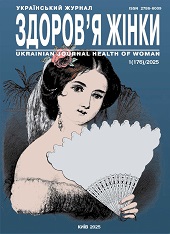Identification and characterization of risk factors for miscarriage in women of the first trimester of gestation
DOI:
https://doi.org/10.15574/HW.2025.1(176).5964Keywords:
miscarriage, first trimester of pregnancy, ultrasound, heat shock proteins, HSP60, GroElAbstract
Ultrasound examination plays a significant role in the diagnosis of threatened abortion. Changes in the structure of the myometrium, pathological ECHO inclusions, morphological changes in the appendages, shortening of the length of the cervix, opening of the internal os, deformation of the fetal egg, pathological localization of the chorion, the presence of retrochorial hematoma, impaired blood flow in the uterine arteries - the main ultrasound characteristics of the threat of abortion.
Aim - to optimize the prediction of miscarriage in women by identifying early risk factors.
Materials and methods. A prospective analysis of 94 pregnant women was conducted. The study included 59 pregnant women who, at the time of blood serum donation, were diagnosed with a threat of miscarriage and/or had a history of complicated pregnancy and childbirth. Anamnestic and biochemical data, ultrasound parameters were analyzed, and univariate and multivariate analysis of the risk of miscarriage was performed.
Results. Univariate analysis revealed a significant increase in the risk of miscarriage with the age of the woman, in the presence of retrochorial hematoma, chorion presentation or pathological attachment, the presence of uterine and adnexal formations and a significant decrease in the risk of miscarriage of vaginitis with an increase in the cervical length index. In univariate analysis, HSP60 and GroEl indicators do not play a role, although GroEL is on the verge of significance. In multivariate analysis, a significant increase in the risk of miscarriage with the presence of retrochorial hematoma, uterine and adnexal formations and a significant decrease in the risk of miscarriage with an increase in the cervical length index and the total number of births. The indicators of multivariate and univariate analysis differ significantly.
Conclusions. The study confirms that ultrasound examination plays an important role in the diagnosis of miscarriage. The presence of retrochorial hematoma, chorion presentation or pathological attachment, the presence of uterine and/or adnexa formations, and shortening of the length of the cervix are risk factors for miscarriage. The risks of miscarriage are associated with the age of the woman and the total number of births. Determination of heat shock protein levels can be taken into account in the complex and indirectly indicate the presence of a risk of miscarriage or a complicated course of pregnancy.
The study was performed in accordance with the principles of the Declaration of Helsinki. The study protocol was approved by the local ethics committee. Informed consent for the study was obtained.
The authors declare no conflict of interest.
References
Bakthisaran R, Tangirala R, Rao ChM. (2015, Apr). Small heat shock proteins: Role in cellular functions and pathology. Biochim Biophys Acta. 1854(4): 291-319. Epub 2014 Dec 30. https://doi.org/10.1016/j.bbapap.2014.12.019; PMid:25556000
Case JT. (1960, May 1). Radiology. Published online. https://doi.org/10.1148/74.5.838b
Cobo T, Kacerovsky M, Jacobsson B. (2020, Jul). Risk factors for spontaneous preterm delivery. Int J Gynaecol Obstet. 150(1): 17-23. https://doi.org/10.1002/ijgo.13184; PMid:32524595
Guo S, Yang H, Liu J, Meng Z, Sui L. (2023). Heat shock proteins in tooth development and injury repair. Int. J. Mol. Sci. 24(8): 7455. https://doi.org/10.3390/ijms24087455; PMid:37108621 PMCid:PMC10138928
Heling KS, Kozlowski P. (2020, Apr). Safety aspects of ultrasound in prenatal diagnosis. Ultraschall Med. 41(2): 116-119. Epub 2020 Apr 7. https://doi.org/10.1055/a-1104-3412; PMid:32259862
Serbina IM. (2019). Clinical and pathogenetic significance heat shock protein with alopecia areata. URL: http://idvamnu.com.ua/wp-content/uploads/2019/11/Serbina.pdf.
Thakur A, Basnet P, Rai R, Agrawal A. (2019, Apr 28). Risk Factors Related to Intrauterine Fetal Death. J Nepal Health Res Counc. 17(1): 46-50. https://doi.org/10.33314/jnhrc.v17i01.1534; PMid:31110376
Vezhnovets TA, Korotky OV, Guryanov VH, Pariy VD, Orabina TM, Pisarev AO, Marushko YV. (2024). Predicting fertility, neonatal and perinatal mortality, stillbirths to assess the needs for perinatal care in the future post-war reconstruction of Ukraine. Wiad Lek. 77(4): 716-723. https://doi.org/10.36740/WLek202404116; PMid:38865628
Wang PS, Rodgers SK, Horrow MM. (2019, May). Ultrasound of the First Trimester. Radiol Clin North Am. 57(3): 617-633. https://doi.org/10.1016/j.rcl.2019.01.006; PMid:30928081
Zhyvetska-Denisova A, Vorobyova I, Skrypchenko N, Lozova L, Shamaeva O, Rudakova N, Stryzhak S. (2024, Dec). Pectin therapy is a method of preventing reproductive losses associated with intraplacental accumulation of radionuclides. Neonatology, Surgery and Perinatal Medicine. 14; 4(54): 110-119 A. https://doi.org/10.24061/2413-4260.XIV.4.54.2024.15
Downloads
Published
Issue
Section
License
Copyright (c) 2025 Ukrainian Journal Health of Woman

This work is licensed under a Creative Commons Attribution-NonCommercial 4.0 International License.
The policy of the Journal UKRAINIAN JOURNAL «HEALTH OF WOMAN» is compatible with the vast majority of funders' of open access and self-archiving policies. The journal provides immediate open access route being convinced that everyone – not only scientists - can benefit from research results, and publishes articles exclusively under open access distribution, with a Creative Commons Attribution-Noncommercial 4.0 international license (СС BY-NC).
Authors transfer the copyright to the Journal UKRAINIAN JOURNAL «HEALTH OF WOMAN» when the manuscript is accepted for publication. Authors declare that this manuscript has not been published nor is under simultaneous consideration for publication elsewhere. After publication, the articles become freely available on-line to the public.
Readers have the right to use, distribute, and reproduce articles in any medium, provided the articles and the journal are properly cited.
The use of published materials for commercial purposes is strongly prohibited.

